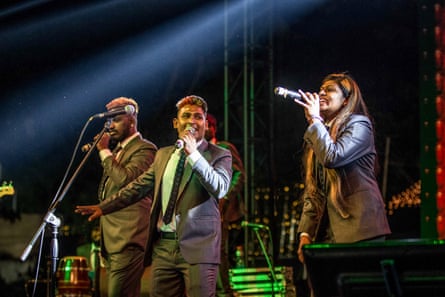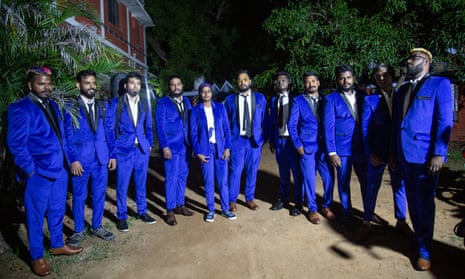When Isaivani starts singing the “beef song” with happy abandon it is nearly 10pm. The audience in the southern Indian city of Madurai seem to have lost track of time and erupt into cheers. Many wave blue flags, dance and whistle in high pitch to the fast tempo of percussion instruments. It is a warm night in October 2019, and very different to the India of today amid coronavirus.
This is a performance by the Casteless Collective, who are using music to shake up India’s notorious caste system of stratified social class. The band wear brightly coloured suits on stage, unusual attire for an Indian group. Isaivani, their sole female member, twirls as she sings high intensity, fast-paced gaana songs.
Gaana has its roots in the northern part of Chennai, the capital of Tamil Nadu, a southern Indian state, and was confined there until it became more widely known through film soundtracks a few years ago. Originally these songs were a mix of dirge and eulogy, philosophical songs sung to keep mourners awake at night – the tradition is that loved ones should stay awake till the corpse leaves the house. Later, gaana songs evolved into depictions of life’s struggles, as north Chennai has a predominantly working class population. During the transition, an undertone of bawdiness crept in, with the songs and singers earning censure.
For Casteless Collective, gaana is a tool to end caste-based discrimination, which features in many spheres of Indian life. Manusmriti, a legal text from the first century BC, has a four-tier social system that places Brahmin priests and intellectuals at the top, then warriors, traders and finally labourers. Dalits – or outcastes – doing sanitary and menial works fell outside this classification altogether.
Though the post-colonial Indian constitution banned caste-based discrimination, the system has persisted and evolved into many sub-castes, deepening the divide. In villages, upper and lower caste people have houses in separate clusters, don’t mingle and have separate drinking water sources. Though not so prevalent in cities, discrimination simmers beneath the surface.
This is what the band wants to eradicate and replace with equality, starting on their home turf. With its image as a place of brawling and bloody crimes, residents of north Chennai, where most members of the band come from, face another social stigma; most of the band members have faced discrimination because of caste, language or their gaana music.
The brain behind the band is Pa Ranjith, a film director known for weaving socio-political issues into his work. He sees gaana as a catchy art form used to express the emotions of everyday life, and compares the Casteless Collective’s efforts to the Black Arts Movement in the US, who championed black creatives during the civil rights era. “Gaana is sung only in funerals, never on stage. We wish to bring it to the mainstream and use it to highlight social issues,” he says.
Ranjith roped in Tenma, an independent musician, to develop the band. “The name Casteless Collective is credited to 19th century anti-caste activist Iyothee Thass, who said that one has to be ‘casteless’ to annihilate caste,” says Ranjith. “The western attire is to change the general perception that gaana singers are badly dressed.”
The band sings about manual scavenging, LGBTQ issues, violence against women, and more – the issues are serious, but not the songs. One is the Tamil version of the “Knock knock, who’s there” joke; it talks about corruption, land grabs and voting rights. The songs have elements of intrigue, humour, melancholy, playfulness and incredulousness tinged with sarcasm. The band’s aforementioned beef song is a take on the belief that beef is a diet of the Dalits; the blue flag being waved at the concert represents Dalit resistance, as it was the flag of BR Ambedkar, architect of the Indian constitution and a Dalit.
Isaivani is one of those who has faced discrimination. As a teen, she eagerly watched music competitions on TV, which included rounds in Carnatic, the classical music of south India. Though she could sing Carnatic-style film songs, she wanted to learn formally, to pick up the nuances. She quit school halfway through her final year exams and approached a traditional music school. “They asked for my caste certificate, and subsequently rejected my application,” she recalls, which left her “extremely upset”.
Isaivani instead focused on her career in commercial troupes that sing film songs at functions. Once, when the audience demanded gaana and there was no male singer, she offered to sing. No one believed that the girl singing melodies could sing gaana, which needs a powerful voice to be heard over the percussion beats. She observed the same scepticism at the Casteless Collective audition. Each time, she quelled the selectors’ doubts with her voice.
The katta molam and satti drums of bandmates Gowtham and Sarath (who, like all the band members, use first names), slung over the shoulder and played with sticks, are instruments associated with death. In certain social strata and regions of Tamil Nadu, percussionists perform during mourning – the hearse follows people dancing to the beat of these instruments throughout the funeral procession, a ritual that has entrenched further prejudices. “People attach an impurity and an ill omen to our instruments and us since we play at funerals,” says Gowtham.

With a Hindu crematorium and a Christian cemetery across the road from their house, Gowtham and his neighbour Sarath heard funeral music every day. Drawn by the drum beats, they experimented with sticks and tin plates fashioned out of decorations in hearses and perfected it. Before they turned 10 they were playing at funerals and earning; both now play for films and continue to perform at funerals. “Because it’s my instrument that has given me recognition now,” says Sarath – for young people, it’s all simply music, irrespective of whether they play at funerals or to an audience of 10,000 as part of the Casteless Collective.
The band’s audience also includes people from privileged backgrounds who want to work towards equality. The public of Chennai, a city well-known for its December classical music concerts, has been very receptive, says Ranjith. However, he says musicians are still reluctant to accept gaana as an art form.
TM Krishna, a popular Carnatic musician who has been outspoken about caste domination in the classical arena, has not seen his counterparts engaging with the band. “I think the directness with which they address caste, gender and religious discrimination makes the Brahmins belonging to the classical universe uncomfortable,” he says. He sees change coming. “The conversation they initiated has a life of its own now. That’s what art does.”
Isaivani sees people talking openly about the pain of being discriminated against. She perceives the overt support and encouragement from upper caste people as a positive impact of their music. “One cannot take on issues as an individual,” she says with conviction. “Through the Casteless Collective, our unified voice will bring about changes.”
As she ends the beef song, the youth in the crowd call out “Isaivani akka” – akka meaning elder sister. Gowtham, who had been intently beating his katta molam, looks up at them and breaks into a happy, satisfied smile. He starts the beat for the “knock, knock” song, and the audience cheers and joins in the refrain.
